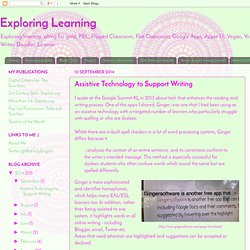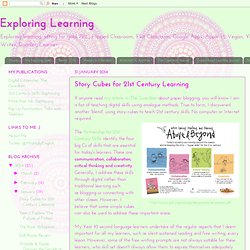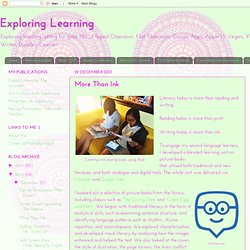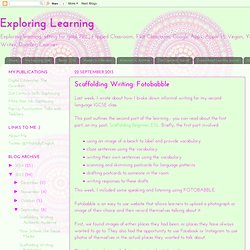

Common Core in Action: Using Digital Storytelling Tools in the ELA Classroom. When students come to school each morning, they have tons of stories -- stories to share with their friends as they unpack or move through the hallways, stories to share with the class during morning meetings, or stories to share with a teacher about something that made them happy or sad.

In the classroom, writing can happen in many different ways, whether it's free writing in a notebook to gather ideas or publishing stories to share with the whole school. The Common Core State Standards expect that children across the grades can write for three specific purposes: Opinion pieces that persuade a reader and make an argument Informative writing that explains an idea and relays information Narrative stories of real or imagined events. As students move from one grade level to another, the complexity of these tasks will change greatly.
The persuasive writing that takes place in a second grade classroom will look very different than the work that a seventh grader produces. Assistive Technology to Support Writing. I spoke at the Google Summit KL in 2013 about tech that enhances the reading and writing process.

One of the apps I shared, Ginger, was one that I had been using as an assistive technology with a targeted number of learners who particularly struggle with spelling or who are dyslexic. Whilst there are in-built spell checkers in a lot of word processing systems, Ginger differs because it ...analyzes the context of an entire sentence, and its corrections conform to the writer’s intended message.
This method is especially successful for dyslexic students who often confuse words which sound the same but are spelled differently. Ginger is more sophisticated and identifies homophones, which helps many EAL/ESL learners too. In readiness for IOS8, you can sign up for the new keyboard app HERE, available from the App Store. Assistive Technology to Support Writing. Assistive Technology to Support Writing.
MrsHollyEnglish : Research about China; so proud... The Future of Fiction. In January, I wrote a post about a unit I was planning that would explore the Future of Fiction with my Year 7s.

We have just come to the end of this great unit, and the work they have produced is amazing. This post outlines what we did and what the learners achieved. It also links to the learning site that I built to deliver this unit, which was successful in teaching not only story elements, storyboarding, drafting and creating, but also problem solving and critical thinking. Our aim was to try to re-tell a story using a technological tool, to see if we think technology can help tell a story. Ultimately, we were trying to decide where we think the future of fiction might be going.
We began by learning about the elements of stories and then used the classic book Where the Wild Things Are to learn about the story mountain as well as plot, character, setting and theme. Story Cubes for 21st Century Learning. If anyone read my article in The Guardian about paper blogging, you will know I am a fan of teaching digital skills using analogue methods.

True to form, I discovered another 'blend': using story cubes to teach 21st century skills. No computer or Internet required. The Partnership for 21st Century Skills identify the four big Cs of skills that are essential for today's learners. These are communication, collaboration, critical thinking and creativity. Generally, I address these skills through digital rather than traditional learning such as blogging or connecting with other classes. MrsHollyEnglish : Story cubes for #EAL kids;...
More Than Ink. Literacy today is more than reading and writing.

Reading today is more than print. Writing today is more than ink. To engage my second language learners, I developed a blended learning unit on picture books that utilised both traditional and new literacies, and both analogue and digital tools. The whole unit was delivered via Edmodo and Google Sites. I booked out a selection of picture books from the library, including classics such as ‘The Giving Tree’ and ‘Green Eggs and Ham’. Flipping the classroom, learners were asked to watch some tutorials on story structure via a playlist created on Sophia.org for homework (read about Playlists in my blog post, Personalised Learning Playlists).
Supporting Struggling Writers with Read&Write for Google. Picture Books Unit of Work for Second Language Learners. Guest on #PSTChat. Scaffolding Writing: Fotobabble. Last week, I wrote about how I broke down informal writing for my second language IGCSE class.

This post outlines the second part of the learning - you can read about the first part, on my post, Scaffolding Beginner ESL. Briefly, the first part involved: using an image of a beach to label and provide vocabularycloze sentences using the vocabularywriting their own sentences using the vocabularyscanning and skimming postcards for language patternsdrafting postcards to someone in the roomwriting responses to these drafts This week, I included some speaking and listening using FOTOBABBLE. Fotobabble is an easy to use website that allows learners to upload a photograph or image of their choice and then record themselves talking about it. First, we found images of either places they had been, or places they have always wanted to go to. Advanced English lessons.